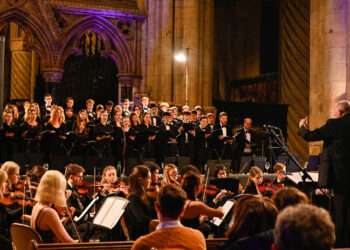In 1610 Monteverdi published a collection of music for Pope Paul V titled Sanctissimae Virgini Missa senis vocubis ad Ecclesiarum Choros ac Vespere pluribus decantandae – “A Mass of the Blessed Virgin for six voices suitable for church choirs and Vespers music for more voices” and it so happened that I heard all of the music from it in the course of two recent concerts in Durham Cathedral.
The second half of the title refers to the music known today simply as “Monteverdi’s 1610 Vespers”, or even just “Monteverdi’s Vespers” and of Monteverdi’s work, it’s probably the one we’re most familiar with, thanks partly to John Eliot Gardiner who launched his career on it. The vespers are full of excitement and colour, mixing choruses and solos, and accompanied with an exotic line-up of instruments; and they balance precariously on one of those boundaries of musical history, looking backwards to the dance music of the Renaissance and forwards to the glittering excitements of the Baroque.
Monteverdi’s book is thought to have been an elaborate way of angling for a job in Rome, and the work that accompanies the vespers was perhaps more carefully calculated to appeal to his audience in Rome, for it is rooted very firmly in the great choral traditions of the Renaissance. It’s name Missa in illo tempore is the first clue – it’s a parody mass, a common technique of the time, in which the music is based on another work, in this instance a motet by Nicolas Gombert. Unlike the vespers, it’s unaccompanied, with a rich, dense choral texture; if I’d switched on the radio and heard it, I wouldn’t have guessed it was by Monteverdi at all.
The vespers concert was put on in the Chapter House by David Stancliffe, conducting his ensemble “The Bishop’s Consort” , with one-per part voices and instruments. It was too long ago now for me to remember enough to write a review but it was a thoroughly enjoyable evening, and the audience particularly appreciated David’s introduction to Monteverdi’s instruments before the performance. Listening to it in this small scale, when it was stripped of its grandeur, I was able to focus on Monteverdi’s lovely melodic lines, particularly in the last few movements.
The Missa in illo tempore came to us by way of the Cambridge Taverner Choir, conducted by Owen Rees, in a concert organised by Durham Cathedral Choir Association; the also included motets by Monteverdi and his Roman predecessors Victoria and Palestrina, and the motet by Gombert on which the mass was based. The Cambridge Taverner Choir had a good, solid tone that carried well in the cathedral, and that worked well for the muscular counter-Reformation period works on the programme – there was plenty of rhythmic excitement, particularly in Monteverdi’s Laudate Pueri that opened the concert and although it was loud and solid, all the detail was there.
I often find that when I go to a concert with lots of short pieces in that there’s one that really grabs me, and in this case it wasn’t a Monteverdi, although both Laudate Pueri and Cantate Domini were fabulous – it was Victoria’s setting of a text from the Song of Songs, Vidi Speciosam. I heard The Sixteen sing it a couple of years ago but it didn’t have the same effect. The text talks about the beloved being surrounded by flowers, and her fragrance rising like incense – heady stuff and with their emphasis on the rhythm, the choir really brought out Victoria’s hypnotic work painting – the music swirled around in circles – I know the settings of the Song of Songs are supposed to reflect Marian devotion but this felt marvellously trippy.
I also wrote a short review for the Northern Echo: http://www.thenorthernecho.co.uk/leisure/music/10566140.Cambridge_Taverner_Choir__Durham_Cathedral_/







